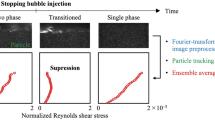Abstract
Based on the (l—v) and (k—ε) models, the present paper examines, both numerically and analytically, the turbulent mixing of two liquids of different densities at the interface between them for various laws of their acceleration, namely, constant, decreasing, increasing, and pulsed ones. The numerical results obtained by these models agree well with each other and with experimental data.
Similar content being viewed by others
REFERENCES
V. E. Neuvazhaev, “Development of turbulent mixing caused by Richtmyer-Meshkov instability, ” Mat. Model., 3, No. 7, 10–28 (1991).
K. Mikaelian, “Turbulent mixing generated by Rayleigh-Taylor and Richtmyer-Meshkov instabilities, ” Physica D, 36, 343–348 (1989).
D. Shvarts, U. Alon, D. Ofer, et al., “Nonlinear evolution of multimode Rayleigh-Taylor instability in two and three dimensions, ” Phys. Plasmas, 2, 2465–2472 (1995).
G. Dimontea and M. Schneider, “Turbulent Rayleigh-Taylor instability experiments with variable acceleration, ” Phys. Rev. E, 54, No. 4, 3740–3743 (1996).
Yu. A. Kucherenko, S. I. Balabin, A. P. Pylaev, et al., “Experimental study of the gravitational turbulent mixing self-similar mode, ” in: Proc. of the 3rd Int. Workshop on the Physics of Compressible Turbulent Mixing ( Abbey of Royamont, France, June 17–19, 1991), S. l, pp. 427–454.
V. E. Neuvazhaev, “On the turbulent-mixing theory, ” Dokl. Akad. Nauk SSSR, 222, No. 5, 1053–1056 (1975).
V. E. Neuvazhaev and V. G. Yakovlev, “Predicting of turbulent mixing under gravity by the (k-ε) model, ” in: Questions of Atomic Science and Engineering, Ser. Theoretical and Applied Physics, No. 1 (1988), pp. 28–36.
V. E. Neuvazhayev, “Turbulent mixing induced by the Richtmyer-Meshkov instability, ” in: Proc. of the 3rd Int. Workshop on the Physics of Compressible Turbulent Mixing ( Abbey of Royamont, France, June 17–19, 1991), S. l, pp. 483–494.
V. E. Neuvazhaev, “Properties of the model of turbulent mixing of the interface between accelerated liquids of different densities, ” Prikl. Mekh. Tekh. Fiz., No. 5, 81–88 (1983).
V. E. Neuvazhaev and V. G. Yakovlev, “A model and method for numerical simulation of the turbulent mixing of an interface moving with an acceleration, ” in: Question of Atomic Science and Engineering, Ser. Techniques and Programs for Solving Problems of Mathematical Physics, No. 2 (1984), pp. 17–25.
D. L. Youngs, “Numerical simulation of turbulent mixing by Rayleigh-Taylor instability, ” Physica D, 12, 32–44 (1984).
K. I. Read, “Experimental investigation of turbulent mixing by Rayleigh-Taylor instability, ” ibid., pp. 45–57.
V. E. Neuvazhaev, “Some properties of the turbulent-mixing model based on the two-component, two-velocity model. Separation additive in diffusion models, ” Mat. Model., 7, No. 7, 3–18 (1995).
Author information
Authors and Affiliations
Rights and permissions
About this article
Cite this article
Neuvazhaev, V.E., Yakovlev, V.G. Turbulent Mixing of Two Liquids with an Arbitrary Law of Acceleration. Journal of Applied Mechanics and Technical Physics 42, 572–580 (2001). https://doi.org/10.1023/A:1019235226588
Issue Date:
DOI: https://doi.org/10.1023/A:1019235226588




